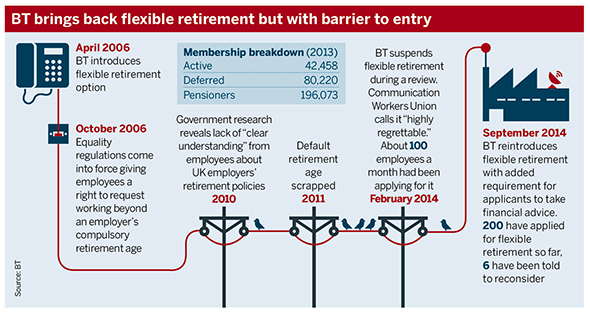BT has reactivated its flexible retirement option following a controversial review, adding a requirement for members to seek advice to ensure they understand its impact on their benefits.
The employer had offered since 2006 a flexible retirement option to the defined benefit scheme’s 42,000 active members, but suspended it earlier this year while it carried out a review. It reinstated the option in September but with a clause demanding that members seek advice before applying for it.
Flexible benefits allow members to begin drawing their pension while continuing to work, giving them more immediate income but potentially leaving them with a lower pension in retirement.
Kevin O’Boyle, head of pensions at the company, said: “We want to make sure employees who do this do it in an informed way. [We] want to make sure they understand the impact on their future benefit.”

He gave the example of a member who had begun to draw their pension while continuing to work, but then became ill and was no longer entitled to an ill-health pension.
O’Boyle said: “A number of people now have to consider when will they leave, but it’s made people realise that if they opt out, ultimately when they leave BT they’ll end up with a lower pension, so I think it’s made people realise the implication.”
The scheme, which closed to new members in 2001, but remains open to future accrual, has received around 200 applications for flexible retirement since the option was reintroduced.
It previously received around 100 a month. O’Boyle said there had been a backlog in applications due to the period when the option was suspended, but that applications had dropped slightly overall.
“We provide access to a financial adviser as part of the service; it’s not a massively onerous requirement but we think it makes sense,” he added.
Ros Altmann, the government’s champion for older workers, said: “I’m really pleased to hear what BT are doing. They are taking the responsible attitude and I hope to see more trustees do the same.”
Steve Herbert, head of benefits strategy at consultancy Jelf Employee Benefits, said the era of greater retirement flexibility could lead companies to keep additional benefits such as death-in-service in place if a member continues to work while drawing their pension.
He said: “There’s already a shift in the market in so far as the default retirement age. There’s a need to provide benefits to older people.”
Jelf’s employee benefit survey for this year found 58 per cent of respondents provided identical benefits to employees over and under age 65, including critical illness plans and group income protection cover.
Anish Rav¹, senior DC consultant at Capita Employee Benefits, said: “It’s important that you give members support in the run-up to making that decision. That advice model is important to manage the risks away.”
He added: “You have to get employees engaged in this quite early in the process.”
Non-financial factors also contribute to whether members should stay in work after retiring, such as the physical strain of the job, Rab said, adding: “For a lot of people it might be attractive but you need to understand the impact.”
¹The original version of this article misspelled Capita Employee Benefits' Anish Rav's name as Anish Rab. This has been updated.














